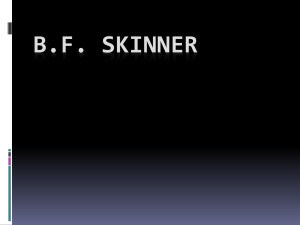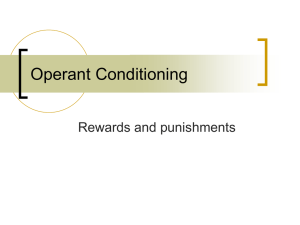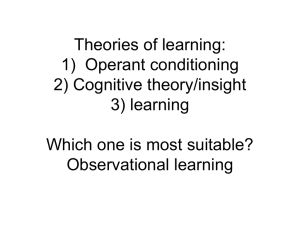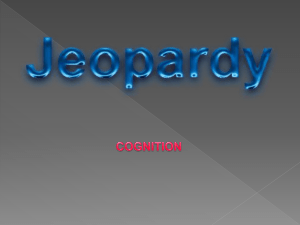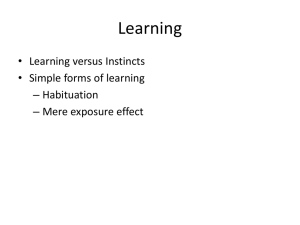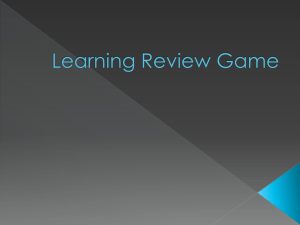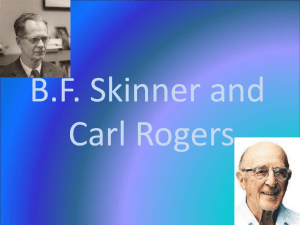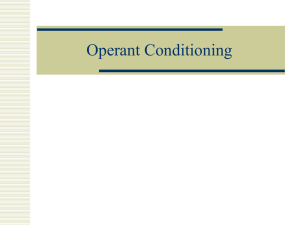Skinner Behavioral Theories by Norbahiah
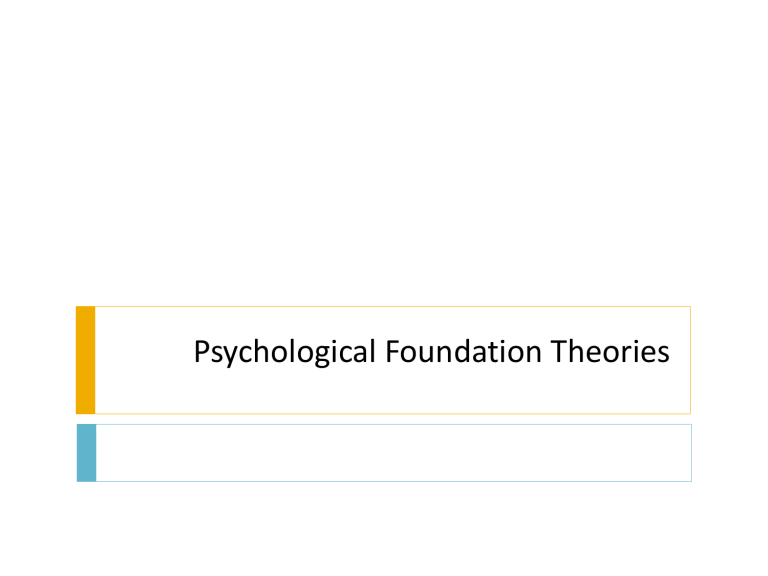
Psychological Foundation Theories
What is Learning ?
“a relatively permanent change in behavior that results from practice.” ( Atkinson et al 1993 ).
Learning is acquiring new knowledge, behaviors, skills, values, preferences or understanding, and may involve synthesizing different types of information.
Learning categories
Through Säljö (1979) research, learning fell into five main categories:
Learning as a quantitative increase in knowledge.
Learning as memorizing.
Learning as acquiring facts, skills, and methods.
Learning as making sense or abstracting meaning.
Learning as interpreting and understanding reality in a different way.
Psychology Learning Theories
Cognitive Theories
Behavioral Learning
Theories
Instructional
Design
Situated Learning
Theories
Instruction Theory
Constructivism
The process / flow ..
ID Designer
Designing
Learning process & outcomes
Psychological
Theories
Cognitive Behavioral Instructional Situated
Effective
Instructional
Design
Constructivism
Behavioral Theories
Behavioral Perspective
Classical Conditioning:
Ivan Pavlov 1849-1936 Classical Conditioning Theory
Behaviorism:
John B. Watson 1878-1958 Behaviorism
Edward L. Thorndike 1874-1949 Connectivism
Edwin Guthrie 1886-1959 Contiguity Theory
B. F. Skinner 1904-1990 Operant Conditioning
William Kaye Estes 1919 - Stimulus Sampling Theory
Neo-behaviorism:
Edward C. Tolman 1886-1959 Sign Theory & Latent Learning
Clark Hull 1884-1952 Drive Reduction Theory
Keneth W. Spence 1907-1967 Discrimination Learning
Behavioral Perspective
Classical
Conditioning:
Stimulus/
Response
• categorize the unconditioned stimulus / response and conditioned stimulus / response
• unconditioned stimulus / response and
• Eg : Dog salivate (salivate unconditioned respond) when they eat (food – unconditioned stimulus)
• conditioned stimulus / response
• Eg : Bell rang (bell unconditioned stimulus) and dog salivate (salivate unconditioned respond)
Behaviorism:
Stimulus,
Response,
Reinforcement
Neo behaviorism:
Stimulus-Response;
Intervening Internal
Variables; Purposive
Behavior
• is more concerned with behavior than with thinking, feeling, or knowing. It focuses on the objective and observable components of behavior.
• The behaviorist theories all share some version of stimulus-response mechanisms for learning
• The neo-behaviorists, then, were a transitional group, bridging the
gap between behaviorism and cognitive theories of learning.
Behavioral Learning Theories
The behavioral learning theory generated by B.F
Skinner that is based upon the idea that learning is a function of change in behavior.
Changes in behavior are the result of an individual’s
response to events (stimuli) that occur in the environment.
B.F Skinner
B.F Skinner
Burrhus Frederic Skinner (March 20,
1904 – August 18, 1990) was born in
Susquehanna, Pennsylvania to Grace and William Skinner
He was an American psychologist, author, inventor, social philosopher, and poet.
Skinner received a PhD from Harvard in 1931, and remained there as a researcher until 1936.
B.F Skinner
He then taught at the University of Minnesota at
Minneapolis and later at Indiana University, where he was chair of the psychology department from 1946–
1947, before returning to Harvard as a tenured professor in 1948.
In 1948, he joined the psychology department at
Harvard University where he remained for the rest of his life
B.F Skinner
He became one of the leader of behaviorism and his work contributed immensely to experimental psychology.
He also invented the “Skinner BOX”, in which a rat learn to obtain food by pressing a lever
Operant Conditioning
BF Skinner
Operant Conditioning
As a behaviorist, Skinner believed that internal
thoughts and motivation could not be used to explain behavior
He suggested to look only at the external, observable
causes of human behavior.
Skinner used the term “operant” to refer to any active behavior that operates upon the environment to generate consequences
Operant Conditioning
Operant conditioning (sometimes referred to as
instrumental conditioning) is a method of learning that occurs through
rewards / reinforcement and punishments for behavior.
Through operant conditioning, an association is made between
a behavior and a consequence for that behavior
Examples of Operant Conditioning
Increasing Behavior Decreasing Behavior
We can find examples of
operant conditioning at work all around us in increasing the behavior
Children completing homework to earn a reward from a parent or teacher
Operant conditioning can also be used to decrease
the behavior by removal of an undesirable outcome or the use of punishment
The children are required to attend the retention class if they did not completed their homework
Operant Conditioning Key Concepts
Stimulus presentation
Stimulus
Removal
Increase behavior
• In an attempt to increase the likelihood of a behavior occurring in the future,
• presentation of an appetitive stimulus.
• In an attempt to increase the likelihood of a behavior occurring in the future,
• the removal of an aversive stimulus.
+ reinforcement
reinforcement
Decrease behavior
+ punishment
• In an attempt to decrease the likelihood of a behavior occurring in the future,
• presentation of an aversive stimulus.
punishment
• In an attempt to decrease the likelihood of a behavior occurring in the future,
• the removal of an appetitive stimulus.
Operant Conditioning Key Concepts
Operant Conditioning
Increase Behavior Decrease Behavior
Positive
Reinforcement
If you stroke a cat's fur in a manner that is pleasing to the cat it will purr. The cat's purring may act as a positive reinforcer , causing you to stroke the cat's fur in the same manner in the future.
Negative
Reinforcement
When a child says "please" and "thank you" to his/her mother, the child may not have to engage in his/her dreaded chore of setting the table. Therefore, not having to set the table will act as a negative reinforcer and increase the likelihood of the child saying "please" and "thank you" in the future.
Positive
Punishment
If you stroke a cat's fur in a manner that the cat finds unpleasant, the cat may attempt to bite you. Therefore, the presentation of the cat's bite will act as a positive punisher and decrease the likelihood that you will stroke the cat in that same manner in the future
Negative
Punishment
When a child "talks back" to his/her mother, the child may lose the privilege of watching her favorite television program.
Therefore, the loss of viewing privileges will act as a negative punisher and decrease the likelihood of the child talking back in the future.
Skinner Box
B.F Skinner
Skinner Box
A Skinner Box is a often small chamber that is used to conduct operant conditioning research with animals
It is an experimental environment that is better suited to examine the more natural flow of behavior.
B.F Skinner became famous for his work with rats using his “Skinner Box” (is also referred to as an
operant conditioning chamber).
Skinner Box
Within the chamber, there is usually a lever (for rats) or a key (for pigeons) that an individual animal can operate to obtain a food or water within the chamber as a reinforcer.
The chamber is connected to electronic equipment that records the animal's lever pressing or key pecking, thus allowing for the precise quantification of behavior.
Skinner Box
The animal’s presses on the levers can be detected and recorded and a contingency between these presses, the state of the stimulus lights and the delivery of the reinforcement can be set up, all automatically.
A Skinner box typically contains one or more levers which an animal can press, one or more stimulus lights and one or more places in which reinforcers like food can be deliver
Schedules of Reinforcement Component
Reinforcement component
Partial
Reinforcement reinforcement is given only part of the times they gives the desired response.
Ratio
Reinforcement
Partial reinforcement is when you're reinforced after a number of the
desired behaviors.
Fixed ratio schedules
Variable ratio schedules
Continuous
Reinforcement reinforcement is given every
time they gives the desired response.
Interval
Reinforcement
With interval schedules you're reinforced only after a certain interval of time
Fixed interval
Schedules
Variables
Interval
Schedules
Schedules of Reinforcement Component
Ratio Reinforcement Fixed Reinforcement
Fixed ratio
Schedules deliver reinforcement after every specific number of response
Variable ratio schedules deliver reinforcement after a random number of responses (based upon a predetermined average)
Fixed interval
Schedules deliver reinforcement for the first response after a fixed length of time since the last reinforcement, while premature responses are not reinforced.
Variable interval
Schedules deliver reinforcement for the first response after a random average length of time passes since the last reinforcement
Fixed ratio
Example: every second response is reinforced
Lab example: rat reinforced with food after each 5 bar-presses in a
Skinner box.
Real-world example:
The student must make three requests using the word “please” before being reinforced.
Advantages
Builds a high response rate. The higher the ratio, the higher the rate.
Disadvantages
An irregular burst of responding can occur if the reinforcement is stopped.
Variable ratio
Example: on average, every third response is reinforced
Lab example: 1 st times 3 times pedal 1 food /2 nd times
5 times 1food / on average, a rat is reinforced for each 10 bar presses
Real world example:
The student may be reinforced on the average three requests. Thus, he may be reinforced following four requests using the word
“please” or following two appropriate requests.
Advantages
Because of its unpredictable.
Reinforcement schedule, the student’s rate of responding remains essentially constant and resistant to extinction.
Disadvantages
Not effective for teaching new behaviors
Fixed interval
Example: reinforcement provided for the first response after 1 second
Lab example: rat is reinforced for the first bar press after 15 seconds passes since the last reinforcement
Real world example:
After 5 minutes has passed, the teacher reinforces the next request in which the student uses the word
“please.”
Advantages
Ease of implementation
Disadvantages
The student stops performing following the reinforcement and begins to work again just prior to the next reinforcement period
Variable interval
Example: reinforcement is provided for the first response after an average of
3 seconds since the last reinforcement.
Lab example: rat is reinforced for the first bar press after an average of 10 seconds passes since the last reinforcement
Real world example:
The student receives reinforcement on the average of every 5 minutes for using the word “please” when making a request. Sometimes the reinforcement occurs after 3 minutes or sometimes after 6 minutes.
Advantages
Ease of implementation. Because the time intervals are of different lengths, the student never knows which response will be reinforced.
This unpredictability creates a steady pattern of responding
Disadvantages
Not effective for teaching new behaviors
Conclusion
When teaching new skills or behaviors, make sure the student understands what behavior is required to earn the reward. Then, each time he performs the behavior,
immediately reinforce him. Timing is everything.
• The shorter the delay between the behavior and
reinforcer, the greater the chance the behavior will be strengthened or increased.
• In contrast, the longer the delay between the behavior and reinforcer, the greater the risk that
another behavior will be inadvertently reinforced.
Reference
Reference
Boeree, D. C. (1998). B. F. SKINNER . Retrieved 2006, from http://webspace.ship.edu/cgboer/skinner.html
Brittan Barker, J. K. (n.d.). Glossary of Terms for the Experimental
Analysis of Behavior. Retrieved from http://www.psychology.uiowa.edu/Faculty/Wasserman/Glossary/ho mepage.html#home
Cooper, S. (2009 ). Theories of Learning in Educational Psychology.
Retrieved 2009 , from http://www.lifecirclesinc.com/Learningtheories/learningmap.html
Ferguson, T. J. (n.d.). The basic Process of Learning. Retrieved from http://www.usu.edu/psycho101/lectures/chp4learning/learning.ht
m
(n.d.). Retrieved from http://inst.usu.edu/~mimi/courses/6260/theorists/Skinner/Skinner.
html

